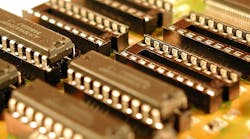Could Semiconductors be the Linchpin to Avert a China-U.S. Trade War?
Citing concerns about record-setting trade deficits between the U.S. and China, and following through on campaign promises, President Trump signed an executive memorandum on March 22 imposing $50 billion in annual tariffs and other penalties on a wide range of Chinese imports. This action follows on President Trump’s imposition of tariffs on steel and aluminum, which will also impact China. China’s response to the earlier tariffs has been to threaten to impose tariffs on $3 billion of U.S. imports.
The announcement of the latest tariffs on Chinese products follows news of record-setting trade deficits between the U.S and China of $375 billion in 2017. The logic behind these new penalties was also framed as a protest against Chinese firms stealing the intellectual property of U.S. firms and rules that force U.S. firms to form joint ventures with Chinese companies in order to access the China market.
Following on the increasingly heated rhetoric surrounding trade issues between the U.S. and China, these latest developments threaten to upset the vibrant electronic and semiconductor economy that has developed between the U.S. and China. While U.S.-headquartered companies account for roughly half of worldwide semiconductor revenues, over 40% of all semiconductor revenues come from shipments to China, where Chinese contract manufacturers and OEMs dominate production of many high-volume electronics product categories. Growth in the electronics and semiconductor industry has been fueled by the open trade environment that has existed for more than two decades.
News of China’s Semiconductor Offer to Avert Trade War with U.S.
In the midst of unsettled financial markets and potential disruption to valuable supply networks, news comes that China is offering to increase the percentage of semiconductor chips it buys from U.S. companies. It’s presents a path to lowering the trade deficit and sets the stage to reach an agreement for a trade relationship moving forward.
These new purchases from U.S. companies would be achieved by replacing chips currently purchased from South Korea and Taiwan. On the surface, this appears to be a positive proposal, but further analysis reveals that the details of this deal may prove problematic.
Does the Math Work?
Worldwide revenues for semiconductors topped $400 billion in 2017. So, it would seem that as the top consumer of semiconductors, China’s offer to shift semiconductor purchases could be a significant gain for U.S. companies. However, when current purchases from South Korean and Taiwanese companies are studied, the potential gains are quickly minimized.
The top two South Korean-headquartered semiconductor suppliers are Samsung Electronics and SK Hynix. They account for over 95% of semiconductor revenues from South Korean companies. In addition, over 85% of their combined revenues come from memory IC products. There are only four U.S. companies with sizable memory IC revenues: Micron, Western Digital, Intel, and Cypress Semiconductor. The current supply-demand imbalance has pushed up prices for memory, and it would be difficult to obtain adequate supply of memory ICs if purchases were to shift from South Korea to U.S. companies.
Five Taiwanese companies account for well over half of all semiconductor product revenue generated from Taiwan. Of these five companies, Nanya's and Winbond’s revenues are dominated by memory IC products and meet the same challenge in shifting demand to U.S. suppliers as described above. Novatek’s revenues are primarily driven by display drivers; there are no major U.S. suppliers in this category. MediaTek and Realtek Semiconductor revenues come primarily from application-specific standard products (ASSPs). However, ASSP revenue from Taiwan is relatively modest compared to shipments between U.S. and Chinese companies.
The bottom line appears to be that no great shift in revenue to U.S. companies can be achieved in China’s proposal. However, other areas could offer much greater benefits.
For example, improved intellectual-property protection guarantees by China could help reduce what some have estimated as a $600 billion annual loss in IP theft suffered by U.S. companies in China. In addition, improving the ability of U.S. companies to compete in China and access a highly valuable China market would be another step. China could take a first step by approving the proposed Qualcomm/NXP merger. These types of actions offer much greater potential value that could form the basis for a U.S.-China trade relationship moving forward.

